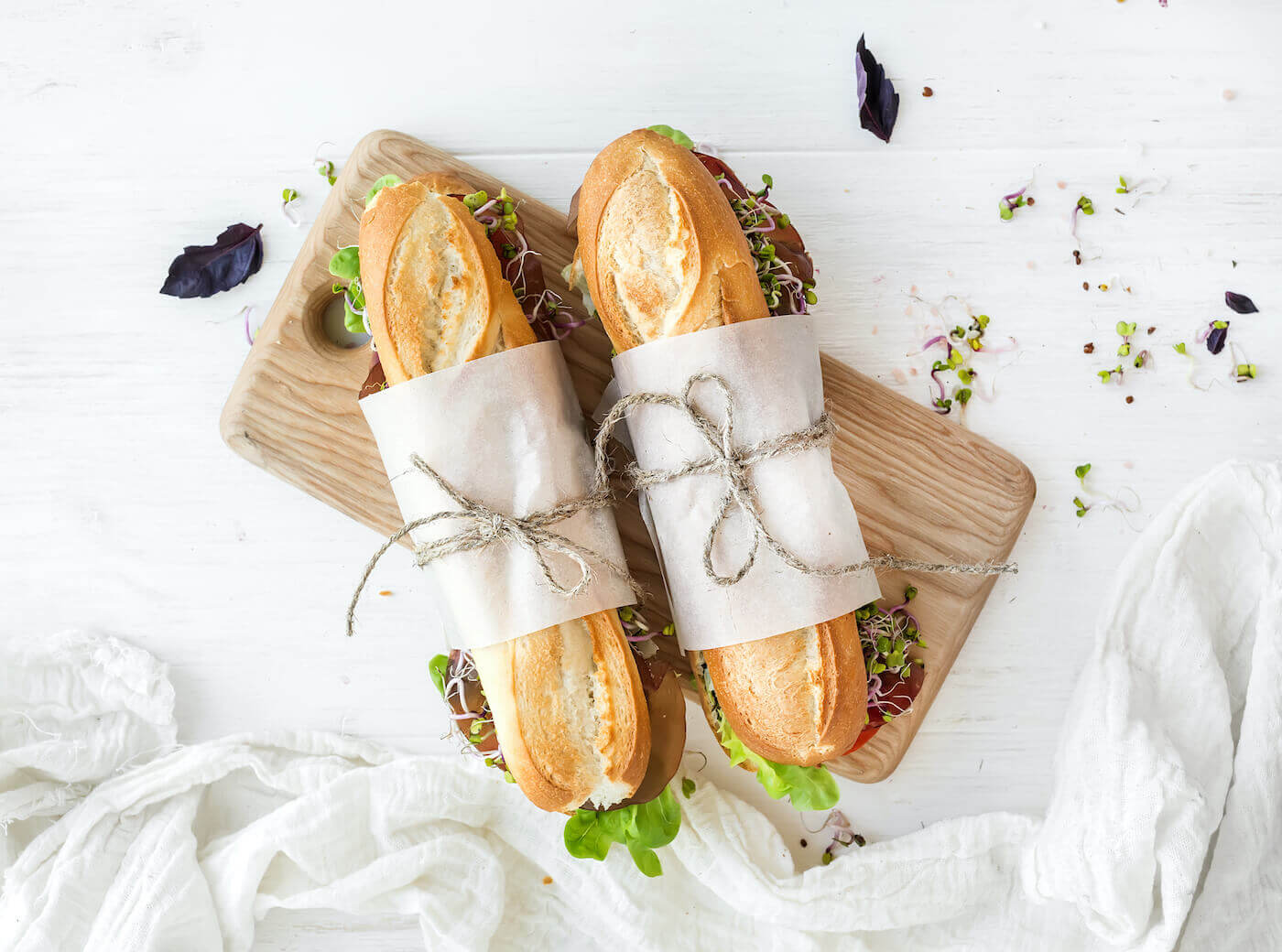Sandwich Bread 101: The Best Breads for Sandwiches
Ah, the sandwich: it evokes nostalgia, it elicits controversy, it has a murky origin story, and it boasts a million or more variations. For a food with such a seemingly simple concept, the sandwich has worked its way into many a complex conversation.
And don’t let anyone tell you a sandwich’s most important ingredients are its fillings. We all know the make-or-break factor is the bread.
With that in mind, read on to discover the best breads for sandwiches.
But First, the Controversy: What Is A Sandwich Exactly?
No story about sandwiches is complete without an attempt at a definition. It’s important to understand what a sandwich is before deciding on the type of bread to use.
The sandwich’s origins are often credited to the 4th Earl of Sandwich in the mid-1700s. As folklore has it, the earl asked for a slice of beef between two pieces of bread so he could continue gambling at cards without setting down the hand.
Regardless of the veracity of the origin story, the food did take on Sandwich’s name. And in simple terms, a sandwich is usually thought of as two slices of bread with filling in between.
Except … what constitutes bread, and what are the fillings? Is a hot dog a sandwich? Or a hamburger? A taco? Sausage and egg on a biscuit? And is an open-faced sandwich an oxymoron? So many questions, so much debate.
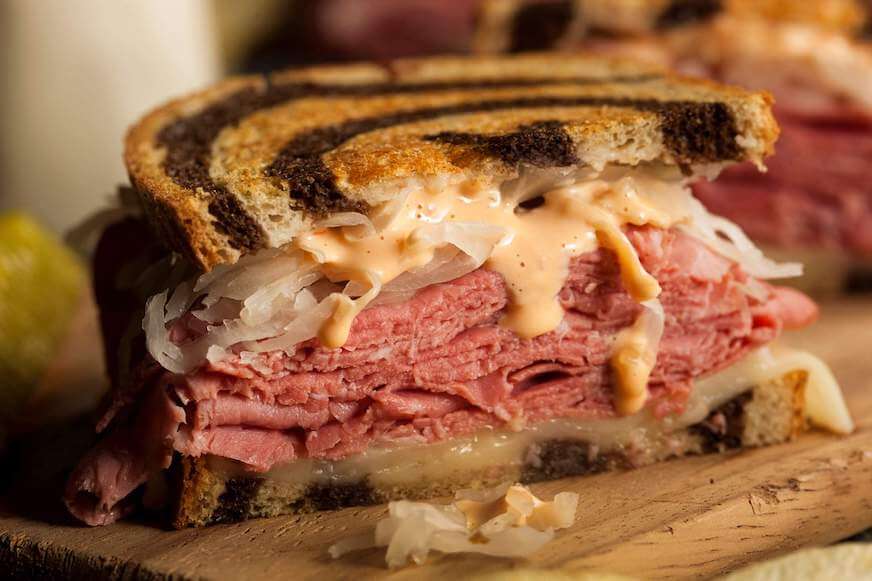
Rye bread is popular with traditional deli sandwiches like corned beef.
The Safe Bet: Traditional Breads for Sandwiches
When you think “sandwich,” these are the kinds of breads that probably come to mind first—supermarket sliced breads that hearken back to school lunches or comfort foods, often sliced diagonally to produce two triangles. (Crusts optional.)
White Bread
Classic white bread is milled and mild, with a soft texture and a thin crust. It allows the fillings to shine.
White bread is popular for grilled cheese sandwiches and the comforting peanut butter and jelly.
Rye
This dense, slightly sour bread is typically seen in one of two color variations, light or dark, depending on the type of flour used and any additional coloring agents. These are sometimes combined to create marble rye. The seeded variety of rye bread incorporates the nutty sharpness of caraway. Pumpernickel is a type of rye bread.
Probably the best known sandwiches using rye bread are melts, rubens and the classic pastrami.
Artisanal Breads for “Fancy” Sandwiches
These breads elevate the sandwich experience a bit, contributing more interesting textures and flavors to the mix.
Ciabatta
With its hearty and open texture and chewy crust, this rustic Italian bread is perfect with almost any kind of sandwich, but is especially known for its use in paninis.
Interesting note: although it seems like an old-world bread, ciabatta is a modern invention—1982, to be exact. A rally car driver in northern Italy, Arnaldo Cavallari—who also owned a mill and produced flour—is credited with creating the recipe to counter the popularity of the French baguette.
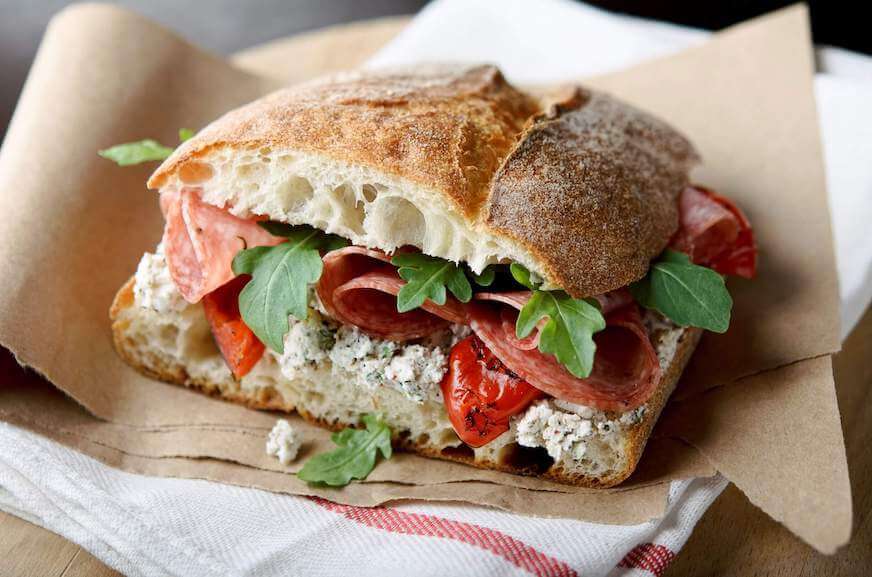
Ciabatta bread is a rustic Italian bread that pairs well with most sandwich ingredients.
Italian
Boasting a crispy crust and soft texture, Italian loaves pair perfectly with spicy meats like salami. This variety is also perfect for delicious spreads.
French baguette
This classical crumbly favorite can go head-to-head with even the juiciest tomatoes and cucumbers. Although a lot of French restaurants will simply serve this bread with plain butter, the baguette can also stand up to the tallest of sandwiches, so pile on the toppings.
Brioche
Brioche is a sweet, tender, melt-in-your-mouth, buttery bread originating in France. It is versatile in that it’s incorporated into breakfast, lunch, and dinner options.
While not typical for sandwich fixings as we know them, they are perfect for sweet or savory fillings—known as en croute.
Culinary & Pastry Career Survey
Culinary & Pastry Career Survey
What's your ideal culinary career? Answer 20 simple questions and see if your dream career gets revealed to you.

We’ve compiled of all of the essential questions into one handy guide: Career options, description of skill requirements, and more!


Sourdough
The subtle tang and hearty weight of sourdough is perfect for grilled cheese, paninis, and just about any type of hot or cold concoctions you can imagine.
Challah
Challah is an eggy bread with no dairy. It’s usually kosher and its taste is slightly sweet.
Challah is good for grilled cheese, lox and cream cheese, and prosciutto and brie (the last of which is decidedly not kosher because of the mix of meat and dairy). Your leftover challah can make incredible French toast, as well.
Secrets of the Perfect Sandwich
Everyone has their favorite techniques, but here are a handful of tips to make your sandwich next-level great:
- Use quality condiments. Swap out a spicy aioli in place of mayonnaise, or try pesto, chutney, or a pepper jelly. Conversely, you can keep it simple but add some interest by buttering your bread and grilling it before assembling your sandwich.
- Use a mix of textures. If your bread is crunchy, consider softer ingredients, and vice versa.
- Spread the condiments out. Instead of slapping a bunch of mayo onto one slice of bread, use the same amount of mayo but spread it onto both slices as well as onto the protein.
- Add some salt and pepper to your lettuce and your vegetables
- Warm up the protein to release the flavors and get a more pleasing mouth feel.
If You Consider Rolls a Sandwich, Try These
Is there a difference between a sandwich, a hoagie, and a sub? Maybe, maybe not. Regardless, these are some delicious options for your fillings-and-bread combos.
Kaiser Roll
The kaiser is a round, hard roll, often seeded on top, and most often associated with a deli.
Chewy and sturdy, the dough is often folded or braided, giving it the appearance of a small challah bread.
Hawaiian Roll
These are light and fluffy with some sweetness; a true Hawaiian roll includes pineapple juice for sweetener.
Sometimes called Portuguese rolls, these are heavenly on their own or used as a sandwich bread. Their size and shape lends itself to sliders, particularly ham and cheese.
Potato Rolls
Potato rolls are also fluffy and moist, though not typically as sweet as Hawaiian rolls.
As the name suggests, these are made with potatoes; potato flour is used in place of some of the wheat flour, with some recipes even calling for mashed potatoes. They’re often used with burgers.
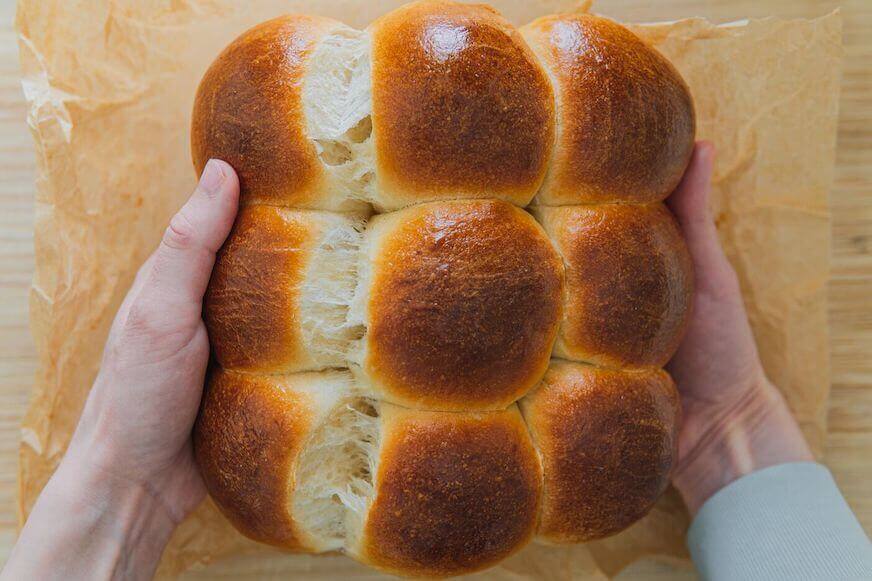
Different types of soft rolls are often used for sandwich bread.
Other Options: From Bagels to Flatbreads
Some folks will say these don’t count as a sandwich, but they’re worth a mention because they can still make for a delicious meal.
Bagels
Typically made with yeasted wheat dough, bagels have dense and chewy insides. You can choose nearly any flavor available to pair with your fillings.
Of course, because bagels have a hole in the middle, you’ll want to be careful what you stack on them.
Focaccia
Focaccia is a flat, leavened bread characterized by indentations on the dough. It falls somewhere between pizza dough and bread, and can be sweet or savory.
Focaccia is often topped with ingredients like arugula and prosciutto and eaten like a pizza or an open-faced sandwich, but it can also be layered with another slice to resemble a more traditional sandwich.
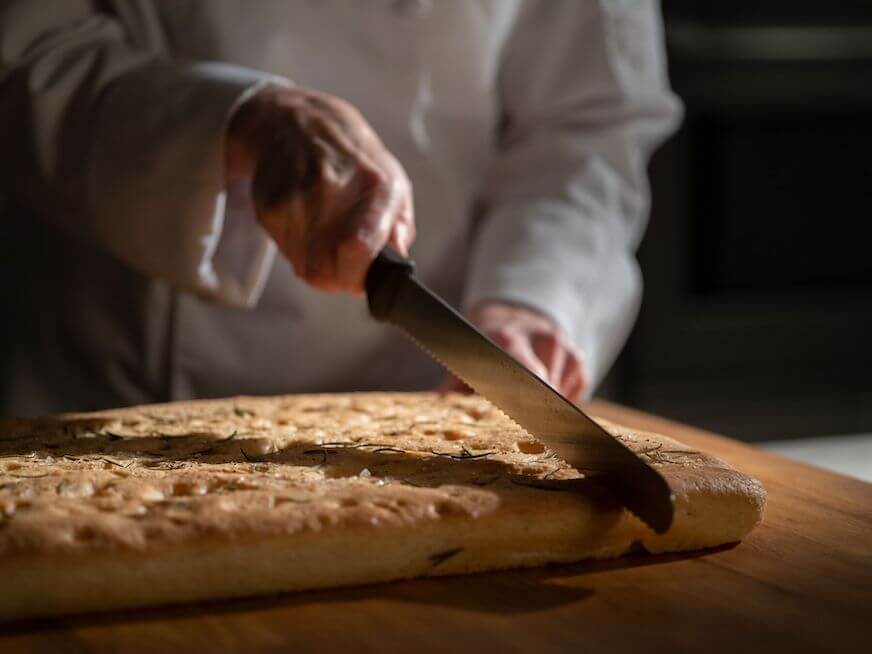
Focaccia bread can be a non-traditional bread for sandwiches.
Pita Bread
Pita bread is one of the oldest types of bread. A flatbread with a hollow middle, pitas are a great mode for stuffing a ton of ingredients into a handheld meal. Pitas also have very little fat and sugar, making them popular with the health-conscious crowd.
Oval in shape, pita bread is cut in half to make two semi-circles with openings for fillings. They are also sliced into triangles and used for scooping hummus and other dips and spreads.
English Muffin
A toasted English muffin is a popular choice for breakfast sandwiches but can be eaten at any meal.
Sturdy and crunchy, with nooks and crannies perfect for buttering, the English muffin also falls within the mild or neutral flavor zone, making it easy to pair with nearly anything.
What to Consider When Choosing Sandwich Bread
Rather than court controversy, we’ve decided to divide up our bread recommendations below into traditional and…less traditional approaches. But whatever side you take in the sandwich wars, some considerations remain consistent, whether you’re starting with a particular loaf of bread in mind or you have something tasty to put inside a sandwich and need to pick an exterior.
Think About Texture
This goes for ingredients as well as bread.
Is the bread hearty and crusty, with a big chomp needed to cut through? If so, soft fillings like tuna or chicken salad may not be the best pairing unless you don’t mind them spilling out. Instead, consider thick slices of meat or freshly-sliced tomatoes with mozzarella and a drizzle of olive oil and balsamic vinegar.
Flavor Pairings—Neutral, Mild, and Strong
Sometimes you want the fillings to grab the spotlight, and sometimes you’re searching for complementary flavors between bread and fillings.
If it’s the latter, some breads, like classic white, are considered “neutral” or “mild” flavors that can pair well with most anything and won’t overpower the flavor of the fillings. Ciabatta is also considered neutral in flavor, with a more interesting texture than sliced bread.
Other breads are slightly sweet, some are a little tangy, and others are herbed or are called hearty. Think about those flavors when making a match; peanut butter on rye is not everyone’s first choice, for example.
Don’t Forget About Oils, Sauces, and Loose Veggies
That white bread might be great for a grilled cheese, but quickly turns soggy for a sandwich with oil. And while a bagel can be a fun option for a fried egg breakfast sandwich, it’s probably not the greatest choice for chicken salad, shredded lettuce, or anything else that can fall through the hole in the middle.
Crusty breads and baguettes are generally great for sopping up oils and sauces. Look for anything with nooks and crannies and an outer crust that can serve as a barrier.
Explore New Combinations and Cooking Techniques
Sandwiches are just one example of a meal that can be taken in many different directions.
If you’re interested in finding out more about how to elevate simple dishes or want to expand upon your understanding of ingredients and cooking techniques, check out our online cooking classes.
America’s Test Kitchen and Escoffier have teamed up to offer top-tier culinary classes to home cooks. After you enroll, you’ll have access to hundreds of individual classes and great recipes. And if you’re looking for a more professional adventure, consider a formal education from Escoffier in Baking & Pastry.
If you want to explore more, try these articles next:
- 5 Tips For Making the Best Burritos
- Beer 101: A Basic Guide For Understanding Beer Styles
- Top Apps For Finding Recipes For Ingredients You Already Have
*This story originally ran on Jan. 14, 2021, and has been updated.

